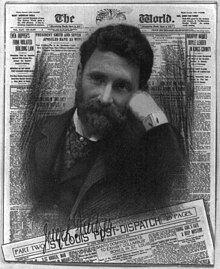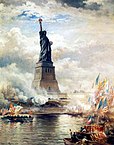Joseph Pulitzer
It was frequented by members of the St. Louis Philosophical Society, including Thomas Davidson, the German Henry C. Brockmeyer; and William Torrey Harris.
Pulitzer spent his free time at the St. Louis Mercantile Library on the corner of Fifth and Locust, studying English and reading voraciously.
They walked back to the city, where Pulitzer wrote an account of the fraud and was pleased when it was accepted by the Westliche Post, edited by Emil Preetorius and Carl Schurz, evidently his first published news story.
[13] In the Westliche Post building, Pulitzer made the acquaintance of attorneys William Patrick and Charles Phillip Johnson and surgeon Joseph Nash McDowell.
On December 14, 1869, Pulitzer attended the Republican meeting at the St. Louis Turnhalle on Tenth Street, where party leaders needed a candidate to fill a vacancy in the state legislature.
He organized street meetings, called personally on the voters, and exhibited such sincerity along with his oddities that he had pumped a half-amused excitement into a campaign that was normally lethargic.
During his time in Jefferson City, Pulitzer voted in favor of the adoption of the Fifteenth Amendment and led a crusade to reform the corrupt St. Louis County Court.
Brown was successful in the November election over the mainline Republican ticket, presenting a serious threat to President Grant's re-election chances.
[21] In May 1872, Pulitzer was a delegate to the Cincinnati convention of the Liberal Republican Party, which nominated New York Tribune editor Horace Greeley for the presidency with Gratz Brown as his running mate.
However, Pulitzer was disappointed with the party's tepid stances on the issues and mediocre ticket, led by gentleman farmer William Gentry.
Pulitzer campaigned for the Democratic ticket throughout the state and published a damaging rumor (leaked by future Senator George Vest) that Gentry had sold a slave.
[23] He also served as a delegate to the 1874 Missouri Constitutional Convention representing St. Louis, arguing successfully for true home rule for the city.
With his own paper, Pulitzer developed his role as a champion of the common man, featuring exposés and a hard-hitting populist approach.
[19][27] The circulation of the Post-Dispatch steadily rose during Pulitzer's early tenure (aided by the collapse of the city's other daily English-language paper, the Star).
[29] Pulitzer's primary political rival at this time was Bourbon Democrat William Hyde, publisher of the (misleadingly named) Missouri Republican.
[31] When Thomas Allen died during his first term, Pulitzer's Post-Dispatch strongly opposed the Republican's endorsed candidate, James Broadhead, an attorney working for the railroad magnate Jay Gould.
The election became heated, and Post-Dispatch managing editor John Cockerill called Broadhead's law partner Alonzo Slayback a "coward."
[19] Pulitzer emphasized broad appeal through short, provocative headlines and sentences; the World's self-described style was "brief, breezy and briggity.
Pulitzer explained that:[41] The American people want something terse, forcible, picturesque, striking, something that will arrest their attention, enlist their sympathy, arouse their indignation, stimulate their imagination, convince their reason, [and] awaken their conscience.In 1887, he recruited the famous investigative journalist Nellie Bly.
Pulitzer dictated several aspects of the design, including the building's triple-height main entrance arch, dome, and rounded corner at Park Row and Frankfort Street.
[42][43] In 1895, the World introduced the immensely popular The Yellow Kid comic by Richard F. Outcault, one of the first strips to be featured in the newly launched Sunday color supplement shortly after.
After the World exposed an illegal payment of $40,000,000 by the United States to the French Panama Canal Company in 1909, Pulitzer was indicted for libeling Theodore Roosevelt and J. P. Morgan.
[44] Newspaper writer and editor of The San Francisco Call, John McNaught went to New York to work under Pulitzer as his personal secretary from 1907 to 1912.
[49] Pulitzer also attacked young Republican Assemblyman Theodore Roosevelt as a "reform fraud," beginning a long and heated rivalry with the future President.
[60] Leander Richardson, a former employee who left the World to run The Journalist, was even more directly antisemitic, referring to his former boss only as "Jewseph Pulitzer.
Pulitzer's health problems (blindness, depression, and acute noise sensitivity)[62] caused a rapid deterioration, and he had to withdraw from the daily management of the newspaper.
After he hired Frank I. Cobb (1869–1923) in 1904 as the editor of the New York World, the younger man resisted Pulitzer's attempts to "run the office" from his home.
[64] In 1878 at the age of 31, Pulitzer married Katherine "Kate" Davis (1853–1927), a woman of high social standing from Georgetown, District of Columbia.
They married in an Episcopal ceremony at the Church of the Epiphany in Washington, D.C.[65] He did not reveal his Jewish heritage to Katherine or her family until after their marriage, to her shock.
In 1902, Columbia's new president Nicholas Murray Butler was more receptive to the plan for a school and journalism prizes, but it would not be until after Pulitzer's death that this dream would be fulfilled.





